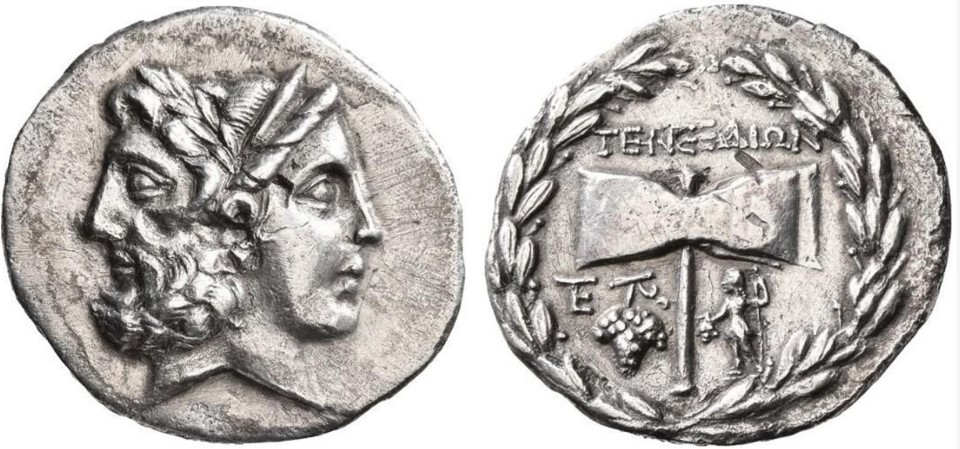100 BCE - 70 BCE | TENEΔIΩN
Overstriking coin
Tenedos_2514_Leu_6.jpg
|
|
Sale(s)Sale(s) ᵖ:
|
Leu Numismatik, 6, 23 Oct. 2020, 175 = rom the Kleinkunst Collection and from the Nelson Bunker Hunt Collection, Sotheby's, 19-20 June 1991, 324, ex Leu 25, 23 April 1980, 140, from the collections of M. Simon, Cahn 68, 26 November 1930, 1448 and Osman Noury Bey, Cahn 60, 2 July 1928, 798, ex Kraus FPL 2, April-June 1928, 834, Feuardent, 9-11 May 1910, 519 and from the collection of A. Rhousopoulos, Hirsch XIII, 15 May 1905, 3518
|
|
|
|
Description
| ObverseInscription or printing placed on the obverse.:
|
Janiform head of a laureate and bearded male to left and a diademed female to right.
|
ReverseInscription or printing placed on the reverse.:
|
TENEΔIΩN (Greek) Large labrys, to lower left, monogram of TE, to lower right, Dionysos standing left, holding grape in his right hand and thyrsos in his left, all within laurel wreath
|
Mint and issuing power
| MintIdentifies the place of manufacture or issue of a numismatic object.:
|
Tenedos
|
Ancient regionAncient region.
|
Troas
|
Modern countryModern country: Turkey
|
AuthorityIdentifies the issuing power. The authority can be "pretended" when the name or the portrait of X is on the coin but he/she was not the issuing power. It can also be "uncertain" when there is no mention of X on the coin but he/she was the issuing power according to the historical sources:
|
|
Chronology
| FromIdentifies the initial date in a range assigned in a numismatic context. 100 BCE toIdentifies the final date in a range assigned in a numismatic context.. 70 BCE
|
Hellenistic 323-30 BC  periodTime period of the numismatic object. periodTime period of the numismatic object.
|
Physical description
MetalThe physical material (usually metal) from which an object is made.: Silver 
|
WeightWeight of the numismatic object (in grams). in grams: 13.6513.65 g <br />13,650 mg <br />
|
DenominationTerm indicating the value of a numismatic object. Examples: tetradrachm, chalkous, denarius.: tetradrachm 
|
AxisDescribes the directional relationship between the obverse and reverse of a numismatic object.: 1212 mm <br />1.2 cm <br />
|
| DiameterDescribes diameter of an object (in mm).: 3434 mm <br />3.4 cm <br />
|
StandardStandard.: Attic
|
References
Description
| ObverseInscription or printing placed on the obverse.:
|
|
ReverseInscription or printing placed on the reverse.:
|
|
Mint and issuing power
| MintIdentifies the place of manufacture or issue of a numismatic object. ᵖ:
|
|
Ancient regionAncient region. ᵖ
|
|
Modern countryModern country:
|
AuthorityIdentifies the authority in whose name (explicitly or implicitly) a numismatic object was issued. ᵖ:
|
|
Chronology
| FromIdentifies the initial date in a range assigned in a numismatic context. toIdentifies the final date in a range assigned in a numismatic context..
|
periodTime period of the numismatic object.
|
Physical description
References
References
- ^ Callataÿ, François de (1998), "Les monnaies hellénistiques en argent de Ténédos", in Georges Le Rider and Roger Bland (eds.), Studies in Greek Numismatics in memory of Martin Jessop Price, London, p. 99-114, pl. 24-28.
- ^ Hoover, Oliver D. (2010), The Handbook of Greek Coinage Series, volume 6 : handbook of coins of the islands: Adriatic, Iionian, Thracian, Aegean, and Carpathian seas (excluding Crete and Cyprus), sixth to first centuries BC, Lancaster, 358 p.
